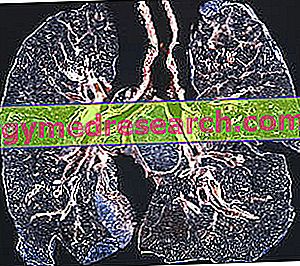Generality
Scarlet fever in adults is a rare but possible phenomenon.

To promote the onset of scarlet fever in adults can be various factors, including, for example, advanced age, stress, contact with a person suffering from scarlet fever, poor night rest, the presence of a chronic disease ( ex: diabetes mellitus) etc.
The effects of scarlet fever in adults are the same as in scarlet fever in children; an adult with scarlet fever, therefore, develops: a rash characterized by dots and scarlet little spots, a first whitish and then red patina on the tongue, sore throat, fever, headache, abdominal pain and tachycardia.
Treatment of scarlet fever in adults involves an antibiotic treatment of about 10 days, associated with rest, isolation of the patient and symptomatic treatment.
Impossible to prevent with a vaccine, scarlet fever in adults tends to resolve itself in a positive way within a week, provided that the therapy is adequate and timely.
What is Scarlet Fever in Adults?
Scarlet fever in adults is the expression that indicates the presence and effects of scarlet fever, an exanthematous disease, in an adult person, therefore aged 20 or over.
What is Scarlet Fever?
To understand what scarlet fever is in adults, it is essential to review some fundamental aspects related to scarlet fever:
- Scarlet fever is an acute infectious disease that occurs due to the action of a bacterium called beta-hemolytic streptococcus of group A or Streptococcus pyogenes ;

- Scarlet fever is one of the most famous and widespread exanthematous diseases; the exanthematous diseases are those morbid conditions of infectious origin, which determine a rash (or rash), that is signs on the skin such as, for example, spots, reddened areas, vesicles, papules and / or pustules;
- Scarlet fever mainly affects children ; more particularly, it has a predilection for subjects aged between 3 and 10 years ;
The marked tendency of scarlet fever to afflict the young population is explained by the presence, in the 3-10 year-old human being, of an immature immune system not yet ready to face a bacterium such as group A beta-hemolytic streptococcus.
- Scarlet fever can also affect infants, adolescents and adults, although these individuals all possess efficient immune defenses for different reasons;
- Scarlet fever is an infection that can be transmitted by inhaling droplets of saliva emitted by an affected person during coughing, sneezing and so on. ( transmission by direct contact ) or through contact with objects contaminated by the infectious agent, as they are passed into the hands of a sick individual ( transmission by indirect contact );
- In people it strikes, scarlet fever is typically responsible for: scarlet red dots or little spots on the whole body (it is the exanthema we mentioned earlier), the formation on the tongue of a patina first white and then red, peeling skin, fever, sore throat, abdominal pain, tachycardia and headache;
- Getting sick of scarlet fever does not give permanent immunity, as there are many different strains (ie, many different variants) of group A beta-hemolytic streptococcus.
Causes
The cause of scarlet fever in adults is the same as in scarlet fever in children, namely the group A beta-hemolytic streptococcus bacterium.
Did you know that ...
In humans, in addition to scarlet fever, group A beta-hemolytic streptococcus can cause forms of pharyngitis and skin conditions such as, for example, impetigo, erysipelas, cellulite and necrotizing fasciitis.
What promotes the appearance of scarlet fever in adults?
To promote the appearance of scarlet fever in adults are factors such as:
- Advanced age . With aging, the human immune system tends to weaken and this reduces the effectiveness of defenses against bacteria such as scarlet fever;
- An inadequate night's rest . During nighttime sleep, the human body re-elaborates the proteins introduced by the diet and uses them, to fight potential pathogens. Those who do not sleep enough during the night cannot effectively use proteins for this purpose, so they are more vulnerable to infections;
- Stress . Psychophysical stress can lower the immune system, thus making the human being more vulnerable to infections;
- Direct contact with a person suffering from scarlet fever or with objects belonging to this person.

- The presence of a chronic disease . Chronic diseases typical of adulthood such as diabetes mellitus make the human immune system weaker and less able to defend against infectious agents, such as viruses, bacteria, etc.
- The presence of an infectious disease such as AIDS . Caused by the virus known as HIV, AIDS (or Acquired Immune-Deficiency Syndrome) is an infection that drastically affects the efficiency of the human immune system, to the point that for those affected it represents a danger even the most trivial and common pathogen (eg: the cold virus);
- The absence of the spleen . The spleen is an organ of the immune system; therefore, in its absence compared to when it is present, the chances of developing an infection are much greater.
The absence of the spleen is often related to a surgical operation of removal of the organ in question (splenectomy), carried out with the aim of treating a tumor of the spleen or a rupture of the spleen;
- The chemotherapy practiced for the treatment of a tumor . Chemotherapy has several side effects, including the weakening of the immune system and the consequent predisposition to infections.
It should be noted that an adult could develop scarlet fever even if it does not fall into any of the above mentioned risk factors.
Contagion and Transmission
Like scarlet fever in children, scarlet fever in adults can also be transmitted through the inhalation of droplets of saliva ( via aerosols ) emitted by a patient or through contact with objects contaminated by the infectious agent.
Symptoms and Complications
The symptoms of scarlet fever in adults are similar to the symptoms of scarlet fever in children; this means that the adult person suffering from scarlet fever presents:
- A rash marked by dots and small spots very close to each other, scarlet red and slightly raised;
- A whitish patina on the tongue, which in a few days changes color and becomes red (raspberry tongue);

- Fever at 38 ° C;
- Sore throat;
- Abdominal pains;
- Tachycardia;
- Headache.
EXCELLENT OF THE SCARLATTINA: SOME MORE DETAILS
The rash due to scarlet fever is, in patients of some age and health status, the most characteristic symptom of the condition in question, therefore it deserves a little study.
In scarlet fever patients, dots and scarlet spots appear, first, on the neck, armpits and groin area and, then, within 24 hours, throughout the rest of the body, except on the nose, mouth and chin.
After a few days of scarlet fever, the rash in question leaves room for a fairly obvious process of skin desquamation, which is an example of furfuraceous desquamation .
The rash produced by scarlet fever is never itchy, meaning it never causes itching.
Incubation Times
Scarlet fever in adults has an incubation time ranging between 1 and 3 days (NB: the incubation time of an infectious disease is the space of time that separates the moment of exposure to the responsible pathogen and the time of appearance of the first symptoms ).
Scarlet fever in adults: consequences in pregnancy
Among the possible targets of scarlet fever in adults there are also pregnant women .
In general, scarlet fever in pregnant women does not represent a danger to the future unborn child ; it is in fact very rare that causes fetal malformations and is transmitted from mother to child at the time of birth.
Complications
Before the discovery of antibiotics, anyone who developed scarlet fever (including adults) had a negligible risk of developing complications, such as meningitis, septicemia, severe sinusitis, pneumonia, encephalitis, endocarditis, rheumatic fever and glomerulonephritis, which could also have a fatal outcome .
Today, thanks to the wide availability of drugs against group A beta-hemolytic streptococcus, the aforementioned complications are fortunately rare, as is the danger of death associated with them.
Curiosity: which organs and systems can be affected by the complications of scarlet fever in adults?
- Tonsils;
- Lungs;
- Kidneys;
- Central nervous system;
- Blood;
- Heart.
Diagnosis
In general, for the diagnosis of scarlet fever in adults, information on symptoms is sufficient, provided by the physical examination and the medical history .
At times, however, it may happen that the aforementioned investigations are not exhaustive and that the doctor needs to perform, for diagnostic confirmation, a throat swab .
Of norms, the use of the throat swab for the confirmation of scarlet fever in adults is typical of milder infectious forms, in which the symptomatology is blurred, unclear.
Pharyngeal swab: What is it?
The pharyngeal swab is a diagnostic test that allows to definitively clarify if a certain suffering of the throat is linked or not to a determined pathogenic microorganism.
Briefly, it involves rubbing the tonsils and the pharyngeal mucosa with a special cotton bud, in order to take some cells to be analyzed later in the laboratory.
Therapy
As the therapy of scarlet fever in all other categories of patients, scarlet fever therapy in adults involves:
- Administration of an antibiotic for at least 10 days . The antibiotic is essential to eliminate the bacterial agent that caused the infection (ie group A beta-hemolytic streptococcus) from the body.
If the adult suffering from scarlet fever is a pregnant woman, it would be advisable for the patient to make contact also with the trusted gynecologist, in order to agree with him the details of the administration (modality, posology, etc.);
- Absolute rest until the end of the febrile state;
- The isolation of the patient, especially during the first days of the illness, to avoid the transmission of the infectious agent to other people;
- A series of symptomatic treatments, ie treatments aimed at alleviating the symptoms.
Which antibiotics are suitable for the treatment of scarlet fever in adults?

In general, doctors treat scarlet fever in adults with oral penicillins or, if the patient has an allergy to these drugs, with macrolides .
Symptomatic Cure of Scarlet Fever in Adults
To alleviate the symptoms of scarlet fever in adults, doctors find it extremely useful:
- The administration of an antipyretic, anti-inflammatory and pain-relieving drug, such as ibuprofen or paracetamol, with the aim of soothing sore throats and reducing fever;
- Drink plenty of water, to avoid the state of dehydration that could result from the presence of fever;
- Humidify the air of the room in which the patient stays during the illness, with the aim of favoring the resolution of the irritation of the throat;
- Consume foods of soft or semi-solid consistency, to minimize throat pain from swallowing food;
- Avoid exposure to irritants, such as active smoking and passive smoking, which have the effect of slowing down the healing process.
Prognosis
If the therapy is timely and adequate, and the patient does not present chronic immunodepression problems, scarlet fever in adults tends to resolve itself for the better in a period of time lasting 7 days .
What Can Lengthen the Healing Times?
The healing time of scarlet fever in adults becomes longer, when the patient is in a precarious state of health (eg: presence of chronic immunodepression) or when the patient neglects antibiotic treatment.
Prevention
Since there is still no vaccine against scarlet fever, adults - as well as all other categories of potential patients - can control the risk of developing group A beta-hemolytic streptococcal infections only with a series of precautions and precautions, such as:
- Avoid sharing cooking utensils and food. This care is justified by the fact that group A beta-hemolytic streptococcus survives for a long time on objects contaminated by it.
- Provide for the cleaning of everything that a scarlet fever or other group A beta-hemolytic streptococcus infection may have touched.
- Taking care of personal hygiene, especially that of the hands. Taking care of personal hygiene is an ideal behavior not only to prevent scarlet fever in adults, but to prevent any infection in any type of patient.



